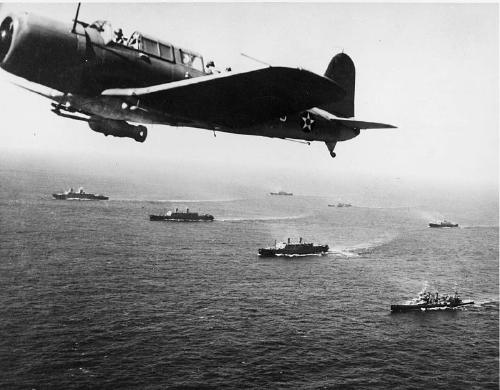World War II: Battle of the Atlantic
World War II: Battle of the Atlantic
 The Battle of the Atlantic was the longest continuous military campaign of World War II, (though some say it was a series of naval military campaigns and offensives) running from 1939 through to the defeat of Nazi Germany in 1945, and was at its height from mid-1940 through to the end of 1943. The Battle of the Atlantic pitted U-boats and other warships of the German Navy (Kriegsmarine) against Allied convoys. The convoys, coming mainly from North America and the South Atlantic and going to the United Kingdom and the Soviet Union, were protected for the most part by the British and Canadian navies and air forces. These forces were aided by ships and aircraft of
the United States from September 13th, 1941. The Germans were joined by submarines of the Italian Royal Navy (Regia Marina) after Italy entered the war on June 10th, 1940.
The Battle of the Atlantic was the longest continuous military campaign of World War II, (though some say it was a series of naval military campaigns and offensives) running from 1939 through to the defeat of Nazi Germany in 1945, and was at its height from mid-1940 through to the end of 1943. The Battle of the Atlantic pitted U-boats and other warships of the German Navy (Kriegsmarine) against Allied convoys. The convoys, coming mainly from North America and the South Atlantic and going to the United Kingdom and the Soviet Union, were protected for the most part by the British and Canadian navies and air forces. These forces were aided by ships and aircraft of
the United States from September 13th, 1941. The Germans were joined by submarines of the Italian Royal Navy (Regia Marina) after Italy entered the war on June 10th, 1940.
The name "Battle of the Atlantic", coined by Winston Churchill in 1941, covers a campaign that began on the first day of the European war and lasted for six years, involved thousands of ships and stretched over hundreds of miles of the vast ocean and seas in a succession of more than 100 convoy battles and perhaps 1,000 single-ship encounters. Tactical advantage switched back and forth over the six years as new weapons, tactics and counter-measures were developed by both sides. The British and their allies gradually gained the upper hand, driving the German surface raiders from the ocean by the end of 1942 and decisively defeating the U-boats in a series of convoy battles between March and May 1943. New German submarines arrived in 1945, but they were too late to affect the course of the war.
|
|
|





 The Battle of the Atlantic was the longest continuous military campaign of World War II, (though some say it was a series of naval military campaigns and offensives) running from 1939 through to the defeat of Nazi Germany in 1945, and was at its height from mid-1940 through to the end of 1943. The Battle of the Atlantic pitted U-boats and other warships of the German Navy (Kriegsmarine) against Allied convoys. The convoys, coming mainly from North America and the South Atlantic and going to the United Kingdom and the Soviet Union, were protected for the most part by the British and Canadian navies and air forces. These forces were aided by ships and aircraft of
the United States from September 13th, 1941. The Germans were joined by submarines of the Italian Royal Navy (Regia Marina) after Italy entered the war on June 10th, 1940.
The Battle of the Atlantic was the longest continuous military campaign of World War II, (though some say it was a series of naval military campaigns and offensives) running from 1939 through to the defeat of Nazi Germany in 1945, and was at its height from mid-1940 through to the end of 1943. The Battle of the Atlantic pitted U-boats and other warships of the German Navy (Kriegsmarine) against Allied convoys. The convoys, coming mainly from North America and the South Atlantic and going to the United Kingdom and the Soviet Union, were protected for the most part by the British and Canadian navies and air forces. These forces were aided by ships and aircraft of
the United States from September 13th, 1941. The Germans were joined by submarines of the Italian Royal Navy (Regia Marina) after Italy entered the war on June 10th, 1940.